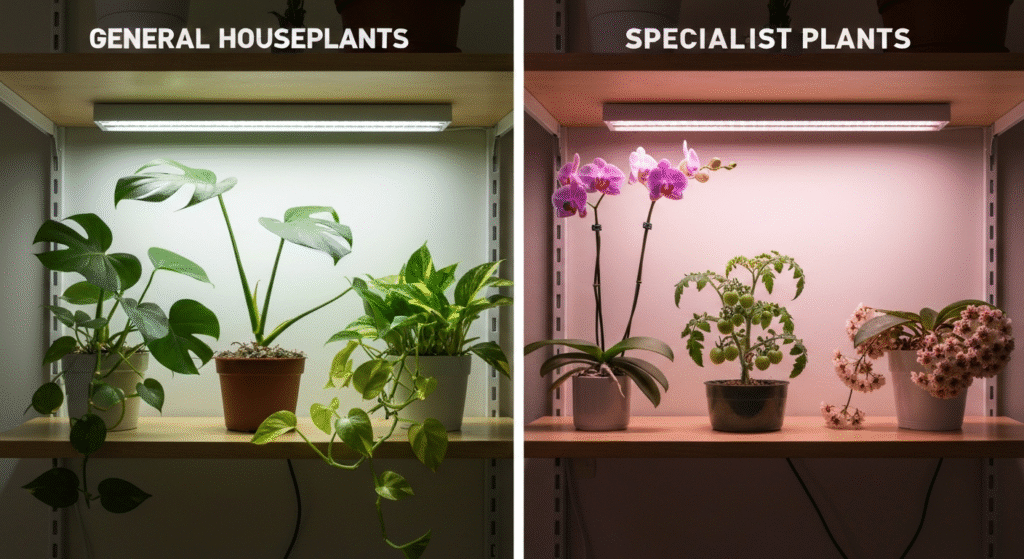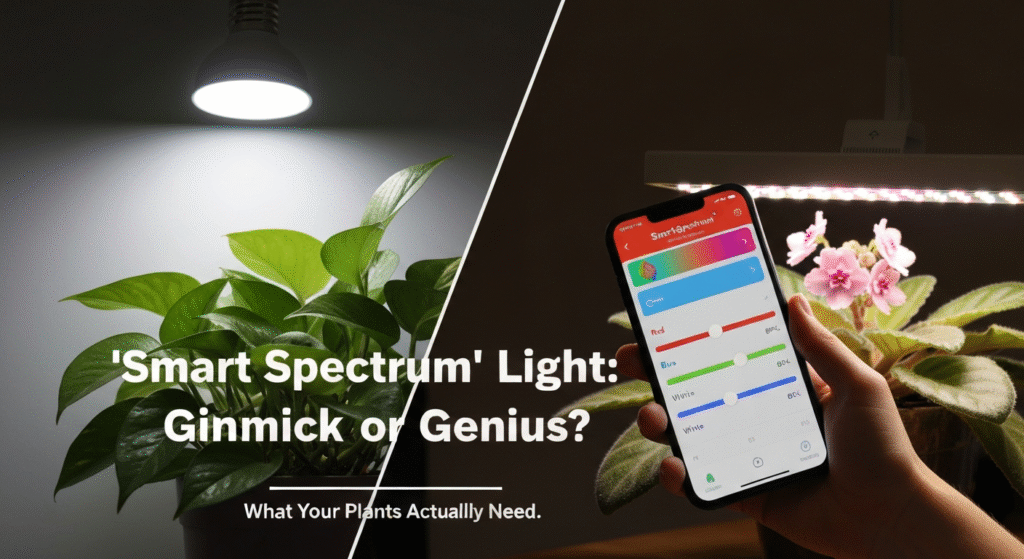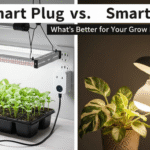We see the “smart” label on everything now: smart plugs, smart speakers, even smart refrigerators. So, when I first saw “smart spectrum” grow lights, I was skeptical. Is this just another gimmick to make us spend more money, or is it a genuine breakthrough for us indoor gardeners? If you’re staring at your sad-looking fiddle leaf fig and wondering if a high-tech light is the answer, you’ve come to the right place.
Hi, I’m Priya. It’s great to have you here. After struggling to keep my first few ‘un-killable’ plants alive in a dim apartment, I fell down the rabbit hole of indoor gardening. That was about five years ago. My journey since has been one of fun (and sometimes frustrating) trial-and-error, turning my home into a smart tech-filled jungle. I’ve become obsessed with testing how technology, especially the right kind of lighting, can help everyday people grow beautiful, thriving indoor gardens, and I love sharing what I learn.
This article breaks down exactly what “smart spectrum” means, cuts through the marketing hype, and helps you decide if it’s a tool your plant collection actually needs.
First, What Does “Light Spectrum” Mean for a Plant?
Before we get “smart,” let’s talk basics. When you and I look at sunlight, we see white light. Plants “see” a whole recipe of different colors, or wavelengths. The most important parts of this recipe are “Photosynthetically Active Radiation,” or PAR.
This is the light plants actually use for energy. For years, we’ve known the two most critical colors in that recipe:
- Blue Light: Think of blue light as the “vegetable” signal. It promotes strong leaf and stem growth. When a plant gets enough blue light, it grows bushy and compact. When it doesn’t get enough, it gets “leggy” or stretched-out, desperately reaching for a source.
- Red Light: This is the “flower” signal. Red light is crucial for telling a plant when it’s time to produce buds, flowers, and fruit. It also plays a big role in root development and overall plant size.
There are other colors, too. Plants do use some green light (it’s a myth that they reflect it all), and other wavelengths like Far-Red can act as specific triggers, like telling a plant the “day” is over.
A “full-spectrum” light, which is the most common type you’ll find, simply tries to provide all these colors at once. It mimics the sun by providing a bit of everything, which is a huge step up from old-school fluorescent tubes.
So, What Makes a Grow Light “Smart Spectrum”?
This is the key distinction.
A full-spectrum light gives you a fixed recipe of light. It’s like a multivitamin—it has a bit of everything, and you can’t change it.
A smart spectrum light (also called “tunable spectrum”) is like having individual bottles of Vitamin B, Vitamin C, and Vitamin D. It’s a light that connects to an app on your phone (usually via Wi-Fi or Bluetooth) and lets you change the recipe of light yourself.
You can tell the light, “Today, I want 60% blue light and 30% red light,” and tomorrow, “Now, I want 30% blue and 60% red.” You become the chef, deciding the exact light diet your plant gets.
This is very different from a simple “smart” grow light, which might just connect to an app to turn on and off. Smart spectrum means you can control the colors.
Here’s a quick breakdown of how they stack up against other common lights.
Grow Light Comparison: Smart Spectrum vs. Full Spectrum vs. “Blurple”
| Feature | “Blurple” (Red/Blue) Lights | White Full-Spectrum LEDs | Smart Spectrum LEDs |
| What it is | Older LED tech using only red and blue diodes. | LEDs that combine colors to look white or off-white to our eyes. | App-controlled LEDs that let you adjust color ratios. |
| Appearance | Unpleasant pink/purple glow. Makes plants look unnatural. | Looks like natural daylight. Easy to live with. | Can be set to white, “blurple,” or any custom mix. |
| Plant Growth | Works, but can be inefficient. Can cause strange, weak growth. | Excellent for 90% of houseplants. A great all-in-one. | Optimized for all growth stages. |
| Control | On or Off. | On or Off (maybe dimming). | Full control: On/Off, schedule, dimming, and color ratios. |
| Best For | Honestly? I don’t recommend them anymore. They are cheap but unpleasant. | General houseplant care, leafy greens, supplemental light. | Specialists, fussy bloomers, fruiting plants, and tech nerds. |
| My Take | I used these once and couldn’t stand the sight of my living room. My plants looked sickly, even if they were growing. | This is my workhorse. 80% of my plants live under these. | This is my “special ops” tool for specific, high-need plants. |
Seeing that table really clarifies things, right? The white full-spectrum lights are the go-to for most of us. The “blurple” ones are, in my opinion, obsolete. The smart spectrum is the high-tech upgrade.
My Own “Aha!” Moment with Smart Spectrum Lights

I need to be honest. For the first few years of my indoor garden journey, I thought “smart spectrum” was a total gimmick. My monsteras, pothos, and philos were growing like weeds under basic $30 full-spectrum LED bars. I thought, “Why would I pay three times that for an app?”
My mind changed because of a stubborn Hoya.
I had this beautiful Hoya carnosa that would grow lovely vines, but it just would not bloom. I tried everything: changing the watering, the humidity, the fertilizer. Nothing. It had been two years of just leaves.
I’d been reading about how a burst of red and far-red light can trigger flowering. On a whim, I invested in my first smart spectrum light and put the Hoya under it. For two months, I left it on a standard “vegetative” setting (more blue and white). Then, I used the app to switch to a “Bloom” preset, which dramatically cranked up the red light and added some far-red.
I’m not exaggerating: three weeks later, I saw my first peduncle (the little stem that a Hoya flower grows on). A month after that, it was covered in blooms.
That’s when it clicked for me. I wasn’t just giving the plant light; I was giving it signals. I was using the light to “speak” to the plant in its own language, telling it, “The season is changing, it’s time to flower.”
The Real Benefits: When Does This Feature Actually Matter?
My Hoya story is a perfect example, but the benefits go beyond just one fussy plant. Here’s where this technology really shines.
Simulating Natural Cycles (Sunrise/Sunset)
This is one of my favorite features. Instead of just “BAM!”—light on at 7 AM—a smart spectrum app lets you create a gentle “sunrise.” It can start with dim, warm red tones and gradually ramp up to bright, white light over 30 minutes. It does the same in reverse for “sunset.”
Why bother? It’s much less stressful for the plant than a sudden jolt of full-power light. More importantly, the “sunset” simulation, especially one that uses far-red light, is a powerful natural trigger for many plants, signaling the end of the day and helping to regulate flowering.
Targeting Specific Growth Stages
This is the big one, especially if you grow plants from the very beginning.
- Seedlings & Clones: Young plants are fragile. They need gentle, high-humidity light. I use a blue-heavy setting, but at a very low intensity (dimmed to 30-40%). This encourages strong root and leaf development without scorching the tender new growth.
- Vegetative Growth: This is for all your leafy plants (like my monsteras) or for plants you’re trying to “bulk up” (like a young fiddle leaf fig). Here, you’d use a preset high in blue and white light. This promotes that compact, bushy, leafy growth.
- Flowering & Fruiting: This is the magic trick. For my African violets, orchids, or the indoor cherry tomatoes I’m experimenting with, I switch them to a red-heavy spectrum. This is the signal that says, “Stop making leaves, start making flowers and fruit.”
Correcting Growth Problems
Have you ever had a succulent or herb that just stretches out, looking pale and weak? That’s “etiolation.” It’s screaming for more light, specifically more blue light.
With a normal light, your only option is to move the light closer, which might burn the plant. With a smart spectrum light, you can just go into the app and increase the blue light ratio. This often corrects the leggy growth without you having to change the light’s position at all. It’s an amazing tool for fine-tuning.
Let’s Be Honest: Do Your Houseplants Need This?
This is the 2,300-word question, isn’t it? After working with these for years, my answer is a very clear: probably not all of them.
The hype can make you feel like every plant needs this. They don’t.
Who Doesn’t Need a Smart Spectrum Light?
Honestly, most casual houseplant owners. If your collection consists of the “easy jungle” plants, you can save your money.
This includes plants like:
- Pothos (all varieties)
- Snake Plants
- ZZ Plants
- Spider Plants
- Most Monsteras
- Most Philodendrons
- Cast Iron Plants
These plants are champions. They are adaptable and tolerant. They just want a light, not a perfect light. My 10-foot golden pothos is thriving under a simple, non-smart, full-spectrum shop light, and it couldn’t be happier. A basic, high-quality white LED light is 100% fine for these plants.
Who Should Consider a Smart Spectrum Light?

This technology is a game-changer for a few specific types of indoor gardeners. I’d say you should consider it if you fall into one of these groups:
- The “Specialist” Gardener: You’re not just growing pothos. You’re into fussy bloomers. This includes orchid enthusiasts, African violet collectors, or anyone trying to get a Hoya or a “string-of-anything” (pearls, hearts) to flower indoors. The ability to trigger flowering with a red-heavy spectrum is worth the price alone.
- The Indoor Food Grower: This is the biggest group that benefits. If you want to grow herbs (like basil and cilantro), leafy greens (lettuce, spinach), or especially fruiting plants (tomatoes, peppers) indoors, a smart spectrum light is a massive advantage. You can keep them in a blue-heavy “veg” state to get big and leafy, then switch to a red-heavy “bloom” state to produce a real harvest.
- The Tech-Lover & Optimizer: This is me. If you love data, love to experiment, and want to dial in the perfect conditions for your prized plants, you will love this. It turns plant care into a fascinating tech hobby, giving you a new level of control.
What to Look For (And What to Ignore) When Shopping
Okay, so you’re in one of those groups and you’re curious. The market is getting crowded, and not all “smart spectrum” lights are created equal. Here’s what I’ve learned to look for.
Key Features That Matter
- App & Connectivity: How does it connect? Bluetooth is fine, but it means you have to be in the same room. I much prefer Wi-Fi-enabled lights. This lets me check on my lights and schedules even when I’m away from home. Also, check that the app is simple and not clunky.
- Good Presets: A good app will come with built-in “recipes” like “Seedling,” “Vegetative,” and “Bloom.” These are a fantastic starting point and, honestly, what I use 90% of the time.
- True Tunability: Does the app only let you change the “white warmth” (from cool to warm)? That’s not true smart spectrum. You want an app that gives you separate sliders for individual color channels (e.g., Blue, Red, White, and sometimes Far-Red).
- PAR/PPFD Data: This is the most important (and most ignored) spec. Don’t look at “Watts.” Watts just tell you how much energy the light uses, not how much light it puts out. You need to find the PAR map or PPFD chart. This tells you the actual usable light intensity at different distances. Without this, you’re just guessing. For a great, simple explanation of these terms, I recommend checking out this article on grow lights from the University of Vermont .
Gimmicks to Avoid
- “Music Sync”: If a grow light’s main feature is that it flashes along to your music, it’s a party toy, not a serious horticultural tool.
- Rainbow Colors: Your plants do not need 16 million RGB color options. They need specific, powerful diodes in the red and blue parts of the spectrum.
- Vague Claims: Avoid any brand that doesn’t show you a PPFD map. If they just say “Super Bright!” or “1000W equivalent,” they are hiding the data that actually matters.
Potential Downsides and Considerations
Before you click “buy,” let’s talk about the downsides. I’ve run into a few.
The most obvious one is cost. A good smart spectrum light can easily cost two to three times as much as a high-quality, “dumb” full-spectrum light of the same size.
The other big one is complexity. More options mean more ways to get it wrong. The first week I had mine, I was worried I’d “burn” my plants with the wrong color recipe. It can be overwhelming.
Here’s a quick summary of the tradeoffs.
Pros and Cons of Smart Spectrum Grow Lights
| Pros | Cons |
| ✅ Precise Control: Target specific growth stages (leaves, flowers). | ❌ Cost: Significantly more expensive than standard lights. |
| ✅ Simulates Nature: Sunrise/sunset features are less stressful for plants. | ❌ Complexity: The number of options can be overwhelming for a beginner. |
| ✅ Problem-Solver: Can help fix issues like leggy growth. | ❌ Tech Reliance: Needs a stable Wi-Fi/Bluetooth connection and a functional app. |
| ✅ Fussy Plant Game-Changer: The key to unlocking blooms in orchids, Hoyas, etc. | ❌ Potential for Error: It’s possible to give your plant the wrong light recipe. |
My little note on this table: That “Cons” list is real. The “complexity” part is why I tell people to start with the built-in presets. Use the “Bloom” or “Veg” settings for a full growth cycle before you try to create your own custom light recipe. Let the experts who designed the app guide you first.
Frequently Asked Questions (FAQs)
1. Can a smart spectrum light fix my dying plant?
Probably not. Light is just one part of the puzzle. If your plant is dying from overwatering (the #1 killer!), root rot, or a pest infestation, a fancy light won’t save it. Fix the root cause first.
2. Is “tunable white” the same as “smart spectrum”?
Not usually. “Tunable white” often just means you can change the color temperature of the white light (from a “cool” blue-white to a “warm” yellow-white). This is nice for human ambiance, but it’s not the same as having independent control over the deep red and deep blue plant-specific diodes.
3. Do I need to run my smart spectrum light 24/7?
No! Please don’t. Plants need a “night” period just like we do. This is when they “exhale” and process their energy (respiration). Running a light 24/7 is a fast way to stress and kill a plant. I run all my lights on a 14 to 16-hour “day” schedule.
4. Can I use one smart spectrum light for all my plants (flowering and leafy)?
You can, but you’ll have to compromise. If you have a Hoya (needs red) next to a Monstera (needs blue) under one light, you can’t give them both their perfect diet. You’d have to settle for a general-purpose “full spectrum” preset. This is why I use them to spotlight specific “zones” in my collection.
My Final Verdict: Is It Worth the Upgrade?
So, back to the big question. After years of using everything from cheap bulbs to these high-tech panels, here is my honest takeaway.
For the average houseplant parent—someone with a lovely collection of pothos, snake plants, and monsteras—a smart spectrum light is a luxury, not a necessity. You will get fantastic results from a standard, high-quality, white full-spectrum light. Please save your money and buy a new plant instead!
However, if you’re like me and have ventured into the more challenging parts of this hobby, they are an absolute game-changer.
If you are trying to get a fussy plant to bloom, if you are growing any food indoors, or if you are a data-driven “optimizer” who loves to experiment, a smart spectrum light is an incredible tool. It’s the closest we can get to handing our plants a customized menu of light.
My final piece of advice? Start with a great full-spectrum light. When you hit a wall—your plants are healthy but just won’t flower, or your herbs are leggy—then consider upgrading that one light to a smart spectrum model. It’s an amazing tool for the dedicated indoor gardener’s toolkit.

